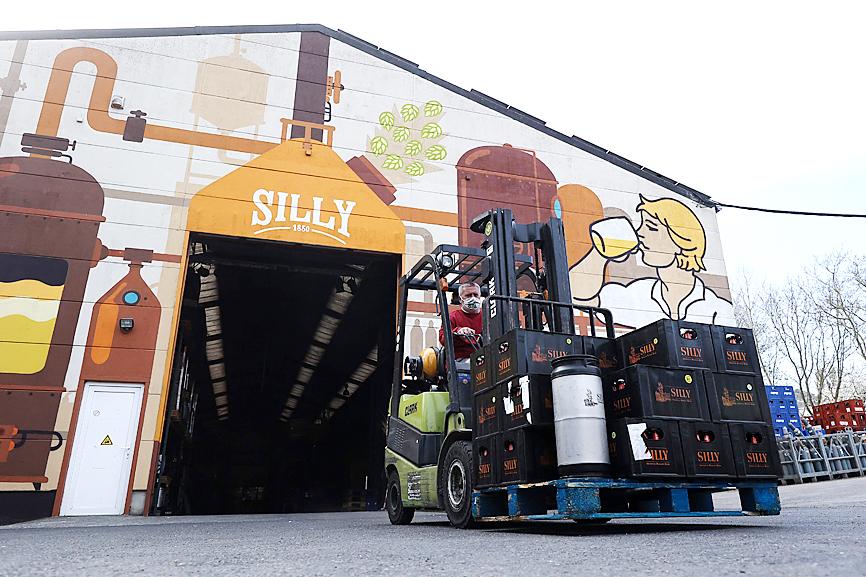Belgium’s cafe terraces are not to reopen to thirsty beer drinkers for another week, but the country’s renowned brewers are already all hands to the pump.
Six months after the country went into a second COVID-19 lockdown, proud bar owners and beer makers alike are keen to get back to business.
They are confident their countrymen and women have not lost their taste for Belgium’s world-famous brews, but the task of getting new barrels into cellars is huge.

Photo: AFP
Warning: Excessive consumption of alcohol can damage your health.
With interior service still banned and social distancing in place — time was running out for some in an industry that has already been hit hard by the pandemic.
“It’s a whole machine that needs to be put back on the road,” said Lionel Van Der Haegen, director of the Silly brewery, in the Belgian village of the same name.
The brewery is working hard, but Van Der Haegen feared for the bars that take his beer.
“Some have gone bankrupt,” he told reporters. “Every day counts. We need to reopen as soon as possible.”
Halting Belgium’s draft beer cycle in October last year was a massive logistical exercise it its own right.
In normal times, heavy beer barrels are rolled into bar cellars full and pulled back out when they are empty and hence much lighter.
However, after bars were ordered closed at the end of October, stocks of beer meant to last for several weeks had to be laboriously hauled up and sent back.
Belgium’s beer culture is recognized by UNESCO as a heritage of international standing and there was no question for Silly, which prides itself on freshness, of simply storing stale beer.
The unsold beers were disposed of carefully and an entirely new batch is under production ahead of Saturday, Belgium’s reopening day.
“It takes between a month and six weeks between the start of brewing and tasting a Silly beer,” said Van Der Haegen, showing reporters around his busy plant.
The Silly brewery dominates the village of just more than 7,000. In normal times it produces 2.5 million liters per year — pale ales, saison, abbey beers, fruit beers, Pilseners, wheat beers and Scotch ale. As reporters toured the plant, a local farmer pulled up in a tractor to collect a trailer-load of distillers grains — dried barley mash left over by the brewing process — to feed his livestock.
The brewery has been in operation since 1850, employs 24 people at full strength, supplies bars across the region and exports bottled beer as far as the US and China.
However, it is at 70 percent capacity and Van Der Haegen does not know how fast things would pick up.
“We’re prepared for it, we’re building up stock, and we’re calling in the teams to set up logistics and prepare orders, call clients, plan deliveries,” he said.
The reopening would be a relief for beer drinkers, as well as bar owners and brewers, but much uncertainty remains. To begin with, bars and restaurants would only open as outdoor terraces.
There would be pent-up demand and some drinkers would doubtless want to celebrate liberally, but others might be nervous of crowds as the pandemic continues.
A rebellious mood is building. Venues in the city of Liege threatened to break lockdown early, and police with water cannons and horses had to break up a mass gathering in a Brussels park.
However, bar managers like Sebastien Weverbergh, who runs an independent cafe adjoining the Silly brewery, said that no-one was better placed than they were to manage a safe return to normal service.
The industry has experience of installing hygiene measures and dealing with exuberant customers, he said, and Belgium needs to get back to the pub.
“Not seeing our clients is a bit like being punished, as if we no longer had the right to see the people who in the end become our friends in this profession,” he said. “The other difficulty is obviously financial. The state has helped us, it has done what it could, but its means are sometimes a little derisory compared to the costs that a restaurant or a cafe generates.”
Belgium has slashed value-added tax from 21 percent to 6 percent to support the reopening, setting aside 835 million euros (US$1 billion) to put some fizz back into the sector.
However, bar owners said that European countries could do more and the industry is pushing the idea of bar reopenings as a motor for post-virus recovery.
“I think it is a symbol of the start of the recovery from COVID, for the whole of society,” said Simon Spillane, director of communications for the association Brewers of Europe. “And yes, we’re hoping for a boom.”
Before the pandemic, there were 11,000 breweries in Europe and the number was surging by almost 1,000 per year as the fashion for small-scale specialists spread.
However, the industry is at 50 percent capacity across the continent, sales in bars and restaurants dropped by 42 percent last year compared with 2019, and increased shop sales did not fill the gap.
“When you’re having a beer on a terrace with your friends, you’re not just supporting the brewers,” Spillane said. “You’re supporting people’s jobs, and you’re supporting the whole economy and the recovery of European society.”

Mercuries Life Insurance Co (三商美邦人壽) shares surged to a seven-month high this week after local media reported that E.Sun Financial Holding Co (玉山金控) had outbid CTBC Financial Holding Co (中信金控) in the financially strained insurer’s ongoing sale process. Shares of the mid-sized life insurer climbed 5.8 percent this week to NT$6.72, extending a nearly 18 percent rally over the past month, as investors bet on the likelihood of an impending takeover. The final round of bidding closed on Thursday, marking a critical step in the 32-year-old insurer’s search for a buyer after years of struggling to meet capital adequacy requirements. Local media reports

US sports leagues rushed to get in on the multi-billion US dollar bonanza of legalized betting, but the arrest of an National Basketball Association (NBA) coach and player in two sprawling US federal investigations show the potential cost of partnering with the gambling industry. Portland Trail Blazers coach Chauncey Billups, a former Detroit Pistons star and an NBA Hall of Famer, was arrested for his alleged role in rigged illegal poker games that prosecutors say were tied to Mafia crime families. Miami Heat guard Terry Rozier was charged with manipulating his play for the benefit of bettors and former NBA player and

The DBS Foundation yesterday announced the launch of two flagship programs, “Silver Motion” and “Happier Caregiver, Healthier Seniors,” in partnership with CCILU Ltd, Hondao Senior Citizens’ Welfare Foundation and the Garden of Hope Foundation to help Taiwan face the challenges of a rapidly aging population. The foundation said it would invest S$4.91 million (US$3.8 million) over three years to foster inclusion and resilience in an aging society. “Aging may bring challenges, but it also brings opportunities. With many Asian markets rapidly becoming super-aged, the DBS Foundation is working with a regional ecosystem of like-minded partners across the private, public and people sectors

BREAKTHROUGH TECH: Powertech expects its fan-out PLP system to become mainstream, saying it can offer three-times greater production throughput Chip packaging service provider Powertech Technology Inc (力成科技) plans to more than double its capital expenditures next year to more than NT$40 billion (US$1.31 billion) as demand for its new panel-level packaging (PLP) technology, primarily used in chips for artificial intelligence (AI) applications, has greatly exceeded what it can supply. A significant portion of the budget, about US$1 billion, would be earmarked for fan-out PLP technology, Powertech told investors yesterday. Its heavy investment in fan-out PLP technology over the past 10 years is expected to bear fruit in 2027 after the technology enters volume production, it said, adding that the tech would